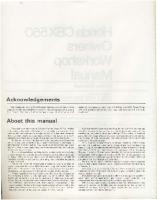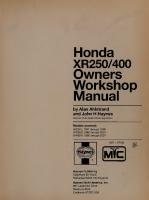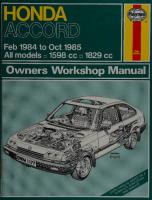Haynes Honda Accord 1984 to 1985 Owners Workshop Manual 1850101779, 185010221X, 9781850102212, 9781850101772
“357 pages : 27 cm Cover title: Honda Accord 1984 thru 1985 Spine title: Honda Accord '84 thru '85 Includes
119 43 35MB
English Pages 364 Year 1986
Recommend Papers
File loading please wait...
Citation preview
Feb 1984 to Oct 1985 PAN Ma alole(=\\c Mumm lolsoM ex eMam (3¥4° Mere
I©HAYNE: 1986
nC
CIPY LIBRARIES __- Reference Department UNDER q THs BooK MUST NOT BE REMOVED TDEPAR E RENC ANY PRETEXT FROM THE REFE RS RENDE RULE THIS OF MENT. INFRINGEMENT N. THE OFFENDER LIABLE TO PROSECUTIO
Before leaving the Library readers must return the books to one of the attendants at the issue desk, or they will be held responsible for them. Readers are required to take care of the books. Writing or drawing with pen, or pencil on any part of a book, or tu 8 down the leaves, or cutting or m e.
them, will be treated as serious
g@
q CONVERSATION IN THE REF MENT IS ANNOYING TO STUDE,
EPARTD IS NOT
PERMITTED.
:
Class.
Accession.
Ds
XM.
Wile. 2220 Sete aeZ 104
15
410 Ni
1990
onda ccord wners
orkshop anual Colin Brown Models covered Honda Accord 1.6 De Luxe, 1.8 Executive & 1.8 EXR Saloon & Hatchback; 1598 cc & 1829 cc Does not cover
1986 model
(1177-9P2)
Haynes Publishing Group Sparkford Nr Yeovil Somerset .BA22 7JJ England Haynes Publications, 861 Lawrence Drive Newbury Park California 91320 USA
Inc
KLMNo
|EDINBURGH CITY LIBRARIES
yo
Acknowledgements Thanks are due to the Champion Sparking Plug Company Limited who supplied the illustrations showing the spark plug conditions. Thanks are also due to Sykes-Pickavant who supplied some of the workshop tools; and all those people at Sparkford who assisted in the production of this manual.
© Haynes Publishing Group 1986, 1988 A book in the Haynes Owners Workshop
Manual
Printed by J. H. Haynes & Co. Ltd, Sparkford, Somerset BA22 7JJ, England
Series
Nr Yeovil,
All rights reserved. No part of this book may be reproduced or transmitted in any form or by any means, electronic. or mechanical, including photocopying, recording or by any information storage or retrieval system, without permission in writing from the copyright holder.
ISBN 1 85010 177 9 British Library Cataloguing
in Publication
Data
Brown, Colin, 1942Honda Accord (‘84 to ‘85) owner's workshop manual. — (Owner's Workshop Manuals) 1. Honda Accord automobile |. Title Il. Series 628.28'722 TL215.H58 ISBN 1-85010-177-9 Whilst every care is taken to ensure that the information in this manual is correct, no liability can be accepted by the authors or publishers for loss, damage or injury caused by any
errors in, or omissions from, the information given.
.
Contents Introductory pages About this manual Introduction to the Honda Accord General dimensions, weights and capacities Jacking, wheel changing and towing Buying spare parts and vehicle identification numbers Use of English General repair procedures Tools and working facilities Conversion factors Safety first! Routine maintenance
Recommended lubricants and fluids Fault diagnosis
5 5 6 7 9 11 12 13 15 16 17 22 23
Chapter 1
Engine
27;
Chapter 2 Cooling system
63
Chapter 3 Fuel, exhaust and emission control systems
71
Chapter 4 Ignition system
129
Chapter 5
Clutch
142
Chapter 6 Manual transmission
147
Chapter 7 Automatic transmission
175
Chapter 8 Driveshafts
204
Chapter 9 Braking system
208
Chapter 10 Suspension and steering
229
Chapter 11
Bodywork and fittings
254
Chapter 12 Electrical system
296
Index
352
Honda Accord 1.8 Executive (UK model)
Honda Accord 4-door Sedan and LX Hatchback
(North American
models)
About
this manual
[ts aim The aim of this manual is to help you get the best value from your vehicle. It can do so in several ways. It can help you decide what work must be done (even should you choose to get it done by a garage), provide information on routine maintenance and servicing, and give a logical course of action and diagnosis when random faults occur. However, it is hoped that you will use the manual by tackling the work yourself. On simpler jobs it may even be quicker than booking the car into a garage and going there twice, to leave and collect it. Perhaps most important, a lot of money can be saved by avoiding the costs a garage must charge to cover its labour and overheads. The manual has drawings and descriptions to show the function of the various components so that their layout can be understood. Then the tasks are described and photographed in a step-by-step sequence so that even a novice can do the work.
/ts arrangement The manual is divided into twelve Chapters, each covering a logical sub-division of the vehicle. The Chapters are each divided into Sections, numbered with single figures, eg 5; and the Sections into paragraphs (or sub-sections), with decimal numbers following on from the Section they are in, eg 5.1, 5.2, 5.3 etc.
Introduction
It is freely illustrated, especially in those parts where there is a detailed sequence of operations to be carried out. There are two forms of illustration: figures and photographs. The figures are numbered in sequence with decimal numbers, according to their position in the Chapter — eg Fig. 6.4 is the fourth drawing/illustration in Chapter 6. Photographs carry the same number (either individually or in related groups) as the Section or sub-section to which they relate. There is an alphabetical index at the back of the manual as well as a contents list at the front. Each Chapter is also preceded by its own individual contents list. References to the ‘left’ or ‘right’ of the vehicle are in the sense of a person in the driver's seat facing forwards. Unless otherwise stated, nuts and bolts are removed by turning anti-clockwise, and tightened by turning clockwise. Vehicle manufacturers continually make changes to specifications and recommendations, and these, when notified, are incorporated into our manuals at the earliest opportunity. Whilst every care is taken to ensure that the information in this manual is correct, no liability can be accepted by the authors or publishers for loss, damage or injury caused by any errors in, or omissions from, the information given.
to the Honda
First introduced with the new 1600 or 1800 cc 12 valve engine in 1984 in Hatchback or Saloon form, the Accord range has been further enhanced by the addition of the EXR (UK) and SEi (North America) models in 1985. E Put together, they now form a very impressive range of vehicles
which
Accord are well
engineered,
with typical
Honda
thoroughness
and
attention to detail, with a host of available extras to satisfy the most discerning motorist. These vehicles will indeed form formidable opposition to Honda’s competitors.
General dimensions, weights and capacities Dimensions Overall length: Hatchback SAISON Overall width
167.5 in (4255 mm)
175.4 in (4455 mm) 65.6 in (1665 mm)
ee orescnc ca metinecere sees
Overall height: UK:
53.4 in (1355 mm)
FlatchbaGkiwineccnwiaitat Saloon North America: Hatchback: :caicsinscivgecccs Saloon: Accord Accord LX and SEi VA nce] |oF:(7 i eens pen eb ar Ground clearance:
54.1 in (1375 mm)
51.1 in (1298 mm)
51.9 in (1318 mm) 51.7 in (1313 mm) 96.53 in (2450 mm) 6.5 in (165 mm)
5.7 in (145 mm) 34.1 ft (10.4 m)
Kerb weights Hatchback
UK:
2117 Ib (960 kg) 2150 Ib (975 kg)
Models with air conditioning North America: Refer to vehicle FMVSS label
Capacities Engine oil:
7.0 Imp pt (4.2 US qt, 4 litre)
At assembly
|YELLOW |GREEN |BROWN GREEN
Code
GREEN | BROWN | BLACK
GREEN | BROWN| Smaller rod journal
Ha3e3
Smaller bearing (thicker)
Fig. 1.22 Connecting
BLACK | BLUE
rod bearing identification (Sec 21)
in or rings, as it removes the hard glaze formed on the cylinder walls service. and 8 Hone the cylinder bores using fine grade (400) emery cloth or use a 60° criss-cross pattern. Do not rub straight up and down, around the bores. 9 Inspect the cylinder block face for warpage using a straight-edge across all four edges and down the centre line.
10 If the service limit in the Specifications is exceeded, the cylinder
block should be renewed. 11 If the warpage is below the service limit, it may be possible to have
the cylinder block face skimmed; specialist. 12 On completion
again a job for an engine
repair
of all inspections and rectification, wash the cylinder block in solvent, and then wash again with hot soapy water. 13 Clean all oil and waterways and ensure they are free from obstruction.
56
Chapter 1 Engine PRECISION
STRAIGHT
EDGE
BBBB MN CYLINDER
BORE SIZES (A or B)
Read the letters from left-to-right for No. 1 through No. 4 cylinders.
First Measurement |
Second
Measurement
Third Measurement |
Fig. 1.23 Cylinder bore measurement
(Sec 22)
14 Blow out all orifices, passageways and waterways and block thoroughly, before giving it a coat of clean engine oil.
SS
es
See ee
Se ee geet
23 Pistons and connecting
dry the
ees Me PE ree ee St)
rods — inspection
——_——————————————————
1. The pistons and connecting rods will have been removed, as described in Section 20. 2 The numbers stamped over the con rod and bearing caps do not
refer to its cylinder number, but to the con rod bore size, so mark the caps and con rods in some way to ensure they are not mixed up. 3 If the piston pin appears worn, or new pistons are to be fitted, this will have to be done by your dealer or engine specialist, as the pin is an interference fit in the piston and a hydraulic press is required to press the pin out and in again. 4 Make sure that the pistons are installed with their index mark facing the con rod oil hole (photo). 5 The big-end inspection and bearing selection are described in Sections 20 and 21. 6 If the cylinders have been rebored, or new pistons have been fitted, the piston-to-cylinder clearance must be established and brought into service limits. 7 Measure the piston skirt at a point 0.83 in (21 mm) from the bottom of the skirt. 8 Piston sizes are given in the Specifications. 9 Measure the cylinder bore, as described in Section 22. 10 Calculate the difference between cylinder bore diameter and piston diameter, and select a piston size that will give the specified piston-to-cylinder clearance. : 11 Inspect the connecting rods for signs of burning through overheating, cracks and distortion.
.23.4 Piston-to-conrod orientation
24 Piston rings — removal,
refitting and inspection
CC SS Kw 1
The piston rings can be removed by inserting two or three old feeler
blades underneath them, spaced around the piston, and sliding the ; rings off. 2 Old rings should not be re-used. 3 Before fitting the rings to the piston, the ring end gap must be
Chapter 1 Engine
57
|
Skirt | diameter
|
21mm
PISTON RING
(0.6 -0.8in.)
Fig. 1.25 Measuring the piston skirt (Sec 23)
Fig. 1.26 Piston ring end gap measurement
(Sec 24)
MARK MARK
TOP RING Sy
SECOND RING -~€ fj
i
=
OIL RING
SPACER
Fig. 1.27 Piston ring fitting order (Sec 24) 24.4 Measuring piston ring end gap
TOP RING established by pushing each ring into its cylinder (use an old piston)
until it is positioned as shown in Fig. 1.26.
4
Measure the end gap (photo).
5 If the gap is too small, ensure you have the correct rings for your engine. 6 If the gap is too large, recheck the cylinder bore diameter against the Specifications. If the bore is too large, the cylinder block must be renewed. 7 \f new piston rings are to be fitted to old pistons, then the inside top periphery of the new ring should be stepped or chamfered, so that it will clear the wear ridge left in the piston ring groove by the old ring. 8 Clean the piston ring grooves thoroughly.
9 Using a ring expander, or the feeler gauge blade method described earlier, fit the new rings to the pistons. 10 Take note of the piston ring fitting order shown
SECOND
|
RING
HAIE@
in Fig. 1.27.
11 Identify top and second rings by their different profile, and position the rings as shown in Figs. 1.28 and 129!
Fig. 1.28 Identifying top and second rings (Sec 24)
58
Chapter 1 Engine
SECOND
DO NOT position any ring gap at piston thrust surfaces.
RING GAP
Approx. 90°
TOP RING GAP
Approx.
90°
15°
OIL RING GAP
SPACER
DO NOT position any ring gap in line with piston pin hole.
OIL RING GAP
GAP Ha7 eo
a0
oS
e\ 13@
Ss
Me HOLE
7
PLUG
oS
SOLENOID VALVE ACCELERATOR DIAPHRAGM
PUMP
PUMP COVER ——
SECONDARY
H.16891
DIAPHRAGM
Fig. 3.27 Components of the carburettor — North American
models (Sec 31)
Chapter 3 Fuel, exhaust and emission control systems
91
CLEARANCE
fe! wAX
Ea
Fig. 3.28 Tapping out the float pin (Sec 31) ADJUSTING. SCREW
32 Float level-inspection and adjustment
UK models 1
Remove the carburettor top cover as described in Section 31.
Fig. 3.29 Measuring
float level
- UK models
(Sec 32)
2 Tilt the cover so that the float is hanging down. 3 Using a float level gauge, or steel rule, measure the distance from the face of the cover gasket to the face of the float, which should be as specified. 4 Adjust with the float adjusting screw. 5 After setting the float level, back off the float adjusting screw to give a clearance between the float needle and float arm as specified.
North American models (with sight glass) 6 Position the vehicle on level ground. 7 Warm up the engine, blip the throttle several times between and 3000 rev/min, then allow it to idle.
idle AUXILIARY ADJUSTING
MARK
INSPECTION
SCREW
WINDOW
AUXILIARY
H.16864
PRIMARY/SECONDARY PRIMARY/ SECONDARY ADJUSTING SCREW
Fig. 3.30 Float level sight glass on North American (Sec 32) cai
models
Fig. 3.31 Float level adjusting screws on North American models (Sec 32)
©2
8 9 10 not
Chapter 3 Fuel, exhaust and emission
control systems
Let the fuel level stabilise, and then check the sight glass. The fuel level should be touching the centre dot on the sight glass. Adjust by turning the adjuster screws in or out as necessary, but do turn the screws by more than an 1/8 of a turn every 15 seconds.
33 Throttle cable —- removal,
refitting and adjusting
Push back the rubber boot and unscrew the locknut (photo). Pull the cable housing back and slide it out of the throttle bracket. Unhook the cable end from the throttle quadrant. Unhook the other end of the cable from the accelerator pedal. Remove the cable from the stay on the valve cover. Turn the grommet in the engine bulkhead through 90° and pull the Oorwnhncable through into the engine bay. 7 Remove the cable from engine bay. 8 Fit a new cable in the reverse order, but apply sealant to the grommet in the bulkhead after installation. 9 Adjust the cable by first tightening the adjusting nut until the cable is taut; without pulling on the throttle lever. 10 Loosen the adjuster until the specified deflection of the cable is obtained. 11 Tighten the locknut. 12 On completion; check that the throttle is fully closed with the accelerator pedal released, and that full opening is achieved when pedal is depressed.
33.1 View of the throttle and choke cable attachment points at the carburettor Arrows indicate deflection 1 Throttle cable adjuster measurement points 2 Choke cable adjuster
34 Choke cable — removal, refitting and adjustment 1 The choke cable on manual choke versions is removed in the same way as the throttle cable; see Section 33. 2 Oncompletion of refitting the cable, adjust in the same way as the throttle cable, but refer to Specifications for cable deflection. 3 Check that the choke flap is fully closed when the choke is pulled out, and fully open when choke is pushed in. 4 |f the flap does not fully open, turn the adjusting nut until the choke flap moves off the positioning stop tab.
LOCKNUT
5 Continue turning the adjuster until there is no deflection in the cable. 6 Now loosen the adjuster so that the specified cable deflection can be obtained.
I| 35 Automatic
transmission
throttle control
~~
bracket —
' adjustment 1 Disconnect the throttle control cable from the throttle control lever. 2 Remove the bolts and discard the lockplate from the control bracket. 3 Refit the bracket loosely using a new lockplate. 4 Position the special tool between the throttle control lever and the control bracket. Note: a gauge may have to be made up to the dimensions shown if the special tool is not available (Fig. 3.35). 5 Position the bracket with the gauge. 6 Tighten the two bolts and bend over the locking tabs. 7 Recheck the gauge fit, and then remove the gauge and refit the throttle cable to the throttle lever.
a i),





![Honda VT1100 Shadow 1985-1998 Owners Workshop Manual (Haynes Manuals) [1 ed.]
9781563923135, 1563923130](https://ebin.pub/img/200x200/honda-vt1100-shadow-1985-1998-owners-workshop-manual-haynes-manuals-1nbsped-9781563923135-1563923130.jpg)



![Haynes Honda CBR600F2 Fours Owners Workshop Manual [2070]
1563920700, 9781563920707](https://ebin.pub/img/200x200/haynes-honda-cbr600f2-fours-owners-workshop-manual-2070-1563920700-9781563920707.jpg)
